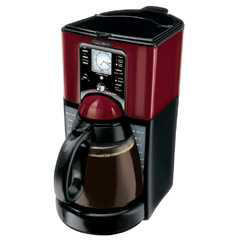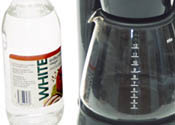

Drip brew (known as Filter Coffee in Europe), is a method for brewing coffee which involves pouring water over roasted, ground coffee beans contained in a filter. Water seeps through the coffee, absorbing its oils and essences, solely under gravity, then passes through the bottom of the filter. The used coffee grounds are retained in the filter with the liquid falling (dripping) into a collecting vessel such as a carafe or pot.
Paper filters (invented by Melitta Bentz in 1908) are commonly used for drip brew all over the world. One benefit of paper filters is that the used grounds and the filter may be disposed of together, without a need to clean the filter. However, metal filters are also common, especially in India. These are made of thin perforated metal sheets that restrain the grounds but allow the coffee to pass, thus eliminating the need to have to purchase separate filters which sometimes cannot be found in some parts of the world. Additionally, many machines now use permanent plastic filters, which are made of a fine mesh. These of course add to the maintenance of the machine, but reduce overall cost.
Drip brewing is the most popular method of coffee brewing, owing to the popularity of domestic coffeemakers. There are, however, several manual drip-brewing devices on the market, offering a little more control over brewing parameters than automatic machines. There also exist small, portable, single serving drip brew makers that only hold the paper filter and rest on top of a cup. Hot water is poured in and drips directly into the cup.
Brewing with a paper filter produces clear, light-bodied coffee, which is free of sediments, but lacking in some of coffee's oils and essences, which are trapped in the paper filter.
A less familiar form of drip brewing is the reversible or “flip” pot commonly known as the Napoletana.


Drip filter coffee makers need to be cleaned monthly to remove hard water deposits (scale), leftover coffee oils that become rancid, and other impurities. Washing the pot just isn't going to cut it--what about the internal components? Follow these steps to clean your coffee maker through and through and you'll taste the difference.
- Make a mixture of 1 part white vinegar to 2 parts water. For a stronger solution (which might be necessary if this is the first time you've cleaned your coffee maker since you got it three years ago) make a mixture that is half vinegar and half water instead. If you don't have any vinegar handy or want to experiment with cleaning mixtures, here are some alternatives:
- a pot's worth of water and two denture tablets
- dissolve 1 oz of citric acid in 4 cups of hot water, then add 4 cups of cold water to the mixture
- 1 part baking soda to 4 parts of warm water
- store-bought coffee maker cleaners
- Put a filter in your coffee maker, as usual.
- Pour the mixture into the coffee maker where you would normally add water.
- Turn the coffee maker on and let the mixture run completely through.
- Discard the filter and mixture.
- Let the coffee maker sit and cool for 15 minutes while it's off.
- Rinse the coffee pot.
- Repeat all of the above twice, but this time with plain cold water. This will make sure all of the vinegar and water solution is completely gone. If short on time, smell the coffee pot and maker after the first rinse. If there is no smell of vinegar left, you can skip the second rinse.
Information Sources: Wikipedia and WikiHow and Image Sources: Mr. Coffee and eHow
Java
French Press | Percolator | Vac Pot | Chemex | Turkish
Pour-Over | Instant | Espresso | Grinding | Water Quality | Java Overview

















































